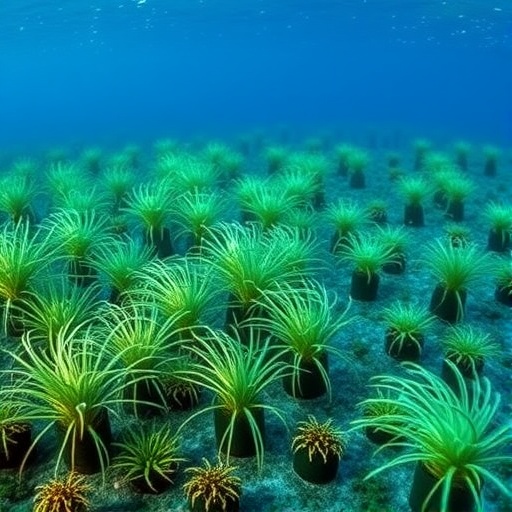Reviving the Underwater Forests: How Microbiome Dynamics Transform Posidonia oceanica Restoration
The underwater meadows formed by the seagrass Posidonia oceanica are some of the most vital and unique ecosystems in the Mediterranean Sea. Often described as the ocean’s equivalent of terrestrial forests, these seagrass beds provide crucial ecological functions: stabilizing sediments, sequestering carbon, and sustaining immense biodiversity. However, accelerated environmental pressures—stemming from coastal urbanization, bottom trawling, boat anchoring, and climate change—have caused alarming declines in these meadows. Scientists worldwide have been racing to develop restoration practices that can reverse these trends and rescue these underwater forests before they vanish.
For years, restoration efforts for Posidonia oceanica have primarily targeted visible indicators of survival: the recovery of roots and growth of leaves following transplantation. Yet, emerging research from the University of Liège, conducted at the STARESO marine station in Corsica, reveals that this approach neglects a crucial hidden player—the microbial community inhabiting Posidonia roots. This root microbiome underpins the plant’s health, resilience, and long-term survival. Without attention to this invisible ecology, restoration projects risk failure despite apparent initial successes.
In this groundbreaking study, researchers explored how different transplantation methods influence the root-associated microbiome during Posidonia restoration. The team tested three main transplantation substrates: metal staples, coconut fiber mats, and structures made from potato starch. Each method affects how roots interact with the sediment—a critical interface where microbial colonization takes place. Metal staples facilitate direct root-to-sediment contact, while the fiber mats and starch-based supports provide more insulated environments, altering microbial establishment patterns.
Analysis revealed stark contrasts in microbial community composition depending on the transplantation method used. Metal staples promoted the early colonization of key bacterial orders such as Chromatiales and Desulfobacterales. These bacteria are crucial drivers of sulfur and nitrogen cycling—processes essential for nutrient availability and detoxification within the rhizosphere. Their presence fosters a microenvironment conducive to healthy root development and overall plant vigor. Conversely, mats and starch supports delayed the establishment of these beneficial bacterial groups, potentially impairing nutrient exchange and weakening plant resilience.
This study delivers a transformative insight for seagrass restoration ecology: the microbiome is not merely a background feature but a fundamental determinant of transplant success. As Dr. Arnaud Boulenger, a lead oceanography PhD candidate at ULiège, emphasizes, “Simply replanting cuttings underwater overlooks the invisible, yet vital, microbial networks upon which these plants depend.” The implications extend beyond marine botany, underscoring the intricate interdependencies between host plants and microbial partners that govern ecosystem resilience.
Moreover, the research sheds light on the functional roles of root-associated microorganisms in the resilience mechanisms of Posidonia. Sulfur-oxidizing bacteria like Chromatiales help mitigate toxic sulfide accumulation in anoxic sediments, safeguarding the roots. Simultaneously, Desulfobacterales contribute to nitrogen fixation and organic matter decomposition, enhancing nutrient availability. These microbial processes synergize to stabilize biogeochemical cycles vital for seagrass growth—a factor restoration efforts have long underestimated.
The findings also open new avenues for innovation in restoration technologies. Sylvie Gobert, oceanographer and co-investigator, suggests that future strategies may incorporate deliberate inoculation of beneficial microbial consortia or the design of transplant supports optimized to foster symbiotic root-microbe interactions. Such bioengineered approaches would mark a radical departure from traditional methods, enabling restoration projects to rebuild not just the seagrass itself, but the entire functional ecosystem from sediment microbes to plant canopy.
This paradigm shift emphasizes that restoring Posidonia oceanica is not solely a botanical endeavor but a holistic ecosystem reconstruction. The seagrass meadow acts as an integrated unit where plant roots and microbial communities form a complex, interdependent web. Efforts that fail to restore this micro-ecological framework risk undermining long-term recovery, as plants deprived of their microbial partners become more vulnerable to stressors.
Given the extensive carbon sequestration capacity of Posidonia meadows, these insights also carry profound implications for climate change mitigation. Seagrass meadows absorb and store large quantities of “blue carbon,” making their preservation a global environmental priority. Enhancing restoration success through microbiome-aware techniques could amplify carbon storage benefits while preserving marine biodiversity hotspots.
In light of accelerating habitat degradation, this research represents a seminal contribution to marine restoration science. It underscores the necessity of adopting interdisciplinary approaches, integrating microbiology, ecology, and marine engineering to confront complex environmental challenges. By illuminating the microbiome’s pivotal role, the study invites scientists, policymakers, and conservationists to rethink restoration paradigms and invest in microbial-informed interventions.
Ultimately, the fate of Mediterranean seagrass meadows may hinge on our ability to unlock the secrets of their microscopic allies. As Arnaud Boulenger aptly summarizes, “Replanting Posidonia is akin to reforesting terrestrial landscapes—not only must saplings be replanted, but the soil itself must be revitalized.” This vision represents a new frontier in restoration ecology, one where the success of planting is measured not just by visible growth, but by the invisible web of life reviving beneath the waves.
Subject of Research: Restoration ecology of Posidonia oceanica, focusing on the impact of transplantation methods on root-associated microbiomes.
Article Title: Microbiome matters: how transplantation methods and donor origins shape the successful restoration of the seagrass Posidonia oceanica.
News Publication Date: 6-Aug-2025
Web References:
DOI link
Image Credits: ULiège / Arnaud Boulenger
Keywords: Posidonia oceanica, seagrass restoration, root microbiome, transplantation methods, sediment interaction, microbial ecology, sulfur cycle, nitrogen cycle, marine conservation, blue carbon, STARESO, marine microbiome




